Looking for the best thermal imaging camera for inspecting your home’s HVAC, plumbing, gas and electrical systems?
This is where your quest ends.
It is important to have a safe and comfortable environment in your house to ensure healthy living. But, most problems like gas leaks and radiation go unnoticed until it is too late. These issues seem minor at first but can lead to many health issues. So, it is better to keep an eye out for them.
Despite how significant it is for you to have your house thoroughly checked, it is not feasible to have someone over for inspection every few months. You can have a thermal imaging camera for a home inspection of your own to deal with this. So, if you want to get a home inspection thermal imaging camera, read on to find out the necessary details.
What’s in This Guide?
This buying guide comprises all the information you need to buy a quality thermal imaging camera for inspecting your home systems. It also includes reviews of the best models we came across in our research.
If you want to use your smartphone, you can check out our article on the best thermal imagers for your smartphone.
Top 4 Thermal Imaging Cameras for Home Inspection
Disclaimer: All links below go to Amazon.com
FLIR E8-XT
Best resolution
Battery Type:
Li ion battery
Temperature Range:
–4°F to +482°F
FLIR TG165 Spot Thermal Camera
Best for the money
Battery Type:
Li ion battery
Temperature Range:
–13 to +716°F
Seek Thermal CompactPRO
Best compact size
Temperature Range:
-40F° to 626°F
BLACK + DECKER TLD100
Best fixed focus
Temperature Range:
86 °F to 302 °F
1. Best resolution thermal imaging camera: FLIR E8-XT
FLIR is one of the most trusted names on the market when it comes to thermal imaging cameras. They come up with various powerful models as per the needs of consumers. Their thermal imagers are not only great for residential purposes but are useful for professional home inspectors as well.
One of the best models they offer is FLIR E8-XT, which has a distinctive resolution power. It has many compelling features that users love in comparison to other available models.
Pros
- Can withstand a drop of 2 meter.
- Instant data transfer via Wi-Fi and Bluetooth.
- Uses a rechargeable Li-ion battery.
- Has a 45° x 34° field of view.
- 2 percent accuracy range of temperature.
Cons
- Software malfunctions sometimes.
Our Review
FLIR E8-XT has one of the best resolution values you will come across on the market. It has a resolution of 320 x 240, which is the ideal rating for thermal imaging cameras. The automatic focus makes it even better, hence, providing crisper images. This makes it great for everyone, whether they are professional home inspectors or not.
Another feature that stands out to us is the presence of multiple modes like thermal, visual, and MSX. This allows for different styles of observations to users based on their preferences and requirements. These modes also create an innovative yet user-friendly interface for a home inspection.
We liked its IP54 enclosure as well since it protects the thermal imager very well. It does not let any damage come to the sensors or lose functioning even when they drop within the safe limit of two meters. This way, you can use the FLIR E8-XT on construction sites without having to take any extra care of the camera.
Moreover, we like its ease of use since it captures MSX improved images on a single pull of the trigger. MSX and VividIR improve the clarity and overall quality of the images and videos; you can pinpoint and get an enhanced image of a section of the thermal image. This helps you focus more on the problem areas that the camera brings to observation.
In addition, it has a temperature range of –4°F to +482°F that covers most kinds of temperature variations in a house. Since it has an accuracy value of 2 percent, there are lesser chances of error. This way, you will make accurate reports of home inspections, and your clients can trust you more.
Since the E8-XT has a lithium-ion battery, it works quite efficiently. This helps in keeping track of all the flaws in plumbing and other issues without fail. So, it is a reliable thermal imaging camera that works amazingly well when it comes to home inspection.
Limitations
The FLIR E8-XT is a great thermal imaging camera, but it has a few limitations. Its pricing can be an issue for those on a strict budget. But, if you consider its features, the price point does not seem that far-fetched. Another slight issue is that its software sometimes malfunctions, causing the users to get stuck.
Bottom Line
The bottom line is that the FLIR E8-XT has a spectacular resolution value. Its battery life and accuracy rating of two percent are also incredible. The temperature range is also quite impressive, so going for this will work well in your favor.
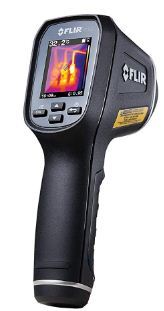
Usually, FLIR thermal imaging cameras are expensive, but some of their models are very cost-effective. The FLIR TG165 spot thermal camera is one of their most budget-friendly models. It has amazing display quality and high-quality construction, which help it stand out from others.
FLIR TG165 has a simple layout and a handy design, which makes using it easier.
Pros
- Rechargeable lithium-ion battery.
- Extensive range of temperature from -13°F to +716°F.
- 8 GB SD card to store data.
- Ten years of thermal imager warranty.
- Can bear a drop of up to 2 meters.
Cons
- Resolution is not great for professionals.
Our Review
The most striking feature of the FLIR TG165 is its temperature range of -13°F to +716°F. It lets you find out all the flaws in wiring and leaks at an initial level.
Since it picks up on minute temperature variations as well, you can use it to find out problems right in their beginning stage.
Other than its temperature range, the 8GB SD card is a show-stealer. It has enough storage to keep all the required data in one place unless you get the time to transfer it.
With this card at hand, you do not have to worry about running out of space while you are working. This way, users stay more organized, even when they are working with multiple things at the same time.
Moreover, there is a warranty of two years
on the overall product and ten years on the thermal imager.
This warranty makes it even more reliable as buyers can claim a repair or replacement in case of any issues. This further increases the security of investment, even when the camera is quite affordable.
Along with all this, the FLIR TG165 is a class II laser product that increases its efficiency. It also has a power output of 1 mW, which does not drain the battery.
Another noteworthy feature is the rugged build. It helps the camera stay intact and fully functional even in case of a drop. However, a drop beyond 2 meters will be too much and can render damage to the camera.
The 9Hz frequency is impressive as well. It helps cover more area in less time, making sure you do not make any mistakes in your observation.
The camera processes images at a desirable pace, so you do not have to worry about missing any spots.
Furthermore, the TG165 has intuitive controls and an easy-to-use layout; you do not need to have any prior training to use it for a home inspection. Just turn on the camera and set the desired configuration without any confusion or hassle.
It is also incredible because of its pocket-carrying capability. You can carry it in your pocket without having to worry about leaving it behind after or before going to work. Just use it and then put it back in your pocket to avoid losing it.
Lastly, it has a tripod mounting, which helps you keep your camera steady while working on inspection.
Limitations
The TG165 is a worthwhile thermal imaging camera considering its features and affordability. It comes at a very affordable price, but there are some drawbacks.
It has an IR resolution of 80 x 60 only, which is way less than the ideal values of 320 x 240. So, you might not like the crispness of its image when compared to other similar cameras.
Another limitation is that it does not have Wi-Fi compatibility, which makes connecting it with other devices hard. However, it has an SD card and USB slot to connect with a computer to transfer the required data.
Bottom Line
Summing it all up, the FLIR TG165 is well worth the money because it offers a lot at a low price. It is quite handy as it has a pocket-carrying form factor.
It also has a nice frame that you can hold for long durations without any hand fatigue. The temperature range is its best feature, so go for it if you want something high in quality and low on price.
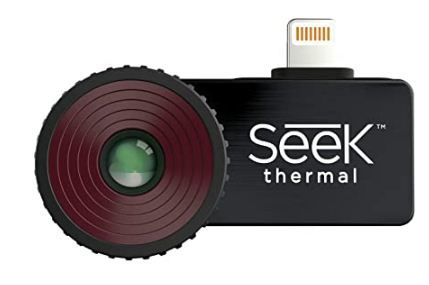
If you are looking for a nice alternative to handheld thermal imaging cameras, the SEEK thermal compactPRO can be great.
It has all that a modern user might want from a thermal imaging camera. But, its biggest plus is that it has a sleek construction, which makes using it easier.
It is essential for those who want to use the least equipment to get their work done.
Cons
- Software requires unnecessary information.
Our Review
SEEK thermal compactPRO is a true savior when it comes to saving money and space. It comes at a pocket-friendly price and does not occupy a lot of space. Rather, it is a sleek and compact model that is quite different from traditional thermal imaging cameras.
One of its most distinguishing features is that it can work with a smartphone or a tablet. It can easily transform your smartphone into a full-fledged thermal imaging camera without having to pay the full price for one.
Moreover, the SEEK Thermal CompactPro has an ideal resolution value of 320 x 240, which is the rating most experts vouch for.
This means that the camera provides crisp and clear images of the objects under inspection. There are hardly any vague points or missing details when you view things with this.
Furthermore, it can be a great aid to hikers and adventurers who want to keep an eye out for animals or people.
It helps you find people even when it is completely dark, and you have only your phone and this camera. This can save you from any major or minor accidents that low visibility might cause.
To top it all off, the CompactPro is a great tool for people who love DIY projects. It can help amateur home decorators see if they have made any mistakes during renovations or decorations.
They can simply put this camera on their phone and then check all the space for any hidden flaws.
Along with this, it comes with a waterproof case that helps protect the camera on construction sites. This case is also useful for keeping the accessories safely in one place.
This camera also has nine color palettes, which means that you can choose the color variations according to your own temperature preferences. This, too, helps in picking out the smallest temperature changes.
In addition, there is a 32° field of view that you can rely on to get better shots of the place under inspection.
It covers more area in one go, so you do not have to keep running the camera over the same spot. Since the CompactPro captures both photos and videos, it is easier for users to choose the kind of display they want.
Limitations
On the whole, the Seek Thermal CompactPro is a wonderful thermal imaging camera. But, it comes with one major shortcoming that users find annoying sometimes.
It needs permission to access the users’ location before starting to work properly. This might make some people feel forced to share their information.
Bottom Line
Keeping all the points in view, SEEK Thermal CompactPro is one of the best thermal imaging cameras with a sleek construction.
It adapts well to other devices to transform them into a camera. The pricing is also great as the features are worth more than the cost.
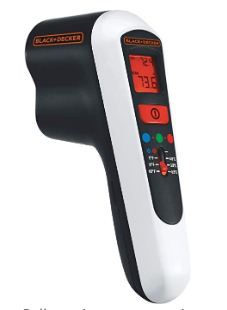
BLACK + DECKER is another trusted name on the market as they have brought many reliable thermal imagers over the years. Their imagers not only have competitive prices but are rich in features - the TLD100 is proof of that.
Pros
- Detects 1, 5, or 10-degree temperature variations.
- Comes with a 2-year warranty.
- Includes a guide for fixing leaks.
- Ergonomic grip for comfortable use.
- Easy to configure with simple controls.
Cons
- Performs basic level inspection only.
Our Review
The BLACK + DECKER TLD 100 is a durable imager that uses infrared sensors to identify hidden damage in a house.
It has a bright LCD screen that you can rely on for accurate temperature readings of objects under inspection.
To add to this, it has an LCD display which uses red to indicate hot and blue to indicate cold. It can scan large areas of space without missing any minor details.
Since this imager shows readings in both Celsius and Fahrenheit, you can use it without needing any other unit converters.
It is great for identifying any HVAC issues as well as damage that might cause problems later on. So, the TLD 100 is ideal for those who want to closely monitor the condition of their house.
Limitations
One of the TLD 100’s few limitations is that it does not scan surfaces as quickly as other options available on the market.
Rather, it takes one to two seconds to change color according to the temperature changes, so you might have to move your hand very slowly to avoid missing any readings.
So, if you are using it, you have to have some patience, which might be a problem if you are need to use it for commercial purposes.
Bottom Line
To conclude, the Black + Decker TLD 100 is an amazing thermal imager that is ideal for use at home.
It has an ergonomic construction that helps avoid hand fatigue, so it will be a great addition to your home inspection kit. It also has simple controls, which makes configuring it easier.
How to Use a Thermal Imaging Camera for Home Inspection
Using a thermal camera for a home inspection is not a difficult task. All of these cameras come with manuals of their own that you can read for specific instructions. But here are the general steps you need to follow to use your thermal imaging camera properly.
- First, insert batteries in the camera and uncover its lens.
- Turn on the power button and let the camera start. Once it is on, set the display configuration from the settings menu to multi-chrome mode. This will let you see different conditions more vividly.
- Adjust the camera's focus by turning the knob around its lens to be able to see things more clearly.
- Now you are all set to inspect your house. Move your thermal imaging camera steadily over all the windows, doors, and other spots in your house. This will let you identify all the leaks or worn out spots in your house.
Common Uses of Home Inspection Cameras
Home inspection cameras are an essential part of every home inspector’s kit. They are quite useful for people who want to keep their house in the best condition, too.
You can use your smartphone for this as well with the help of these thermal imaging apps. These cameras help them identify all the problems in their early stage, so they are a great help. Some of the common uses of thermal imaging cameras for home inspection include:
Airflow
Airflow is an important component of air regulation in a building. This is why you need to check it frequently.
An inconsistent airflow leads to irregular temperature across your house or even in a room. This causes major discomfort to residents, so it is better to have a smooth airflow at home.
This is something that a thermal imaging camera can help you with as it pinpoints blocked ventilators too. Moreover, you can use these to look for HVAC issues in a house before buying or selling it.
Air Leaks
A thermal imaging camera can be handy in checking for air leaks as well. Air leakage can cause unwanted heat gain or loss in a building. Both excessive heat gain and loss can be disturbing, so you need to resolve them timely.
It is better to use a thermal imaging camera to check heat loss when you have a heater on at home at night.
This way, temperature variations are more prominent, and you get to observe the leaks easily. You can also check for heat gain due to air leaks at any time during the day with these cameras.
Roof Insulation
Thermal imaging cameras are great for finding out faults in roof insulation as well.
Poor roof insulation can lead to water leakages as well as air leaks, so you need to be mindful of this. You can monitor roof insulation via these cameras to ensure a moderate humidity level in a house.
Electrical Faults
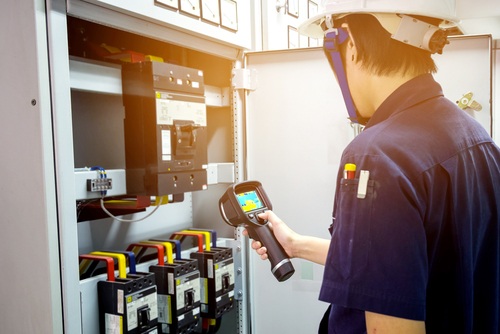
You can use a thermal imaging camera to check electrical faults as well. Most issues in electrical wiring can cause overheating of wires, which can lead to drastic accidents. So, it is better to keep a regular check on them using these cameras.
Mold
Mold growth is highest in wet or moist places. This is why you need to clear out all the accumulated moisture in your house to maintain its good condition.
And, a thermal imaging camera can help you find out the excessive moisture by detecting temperature changes.
How to Select the Best Thermal Camera for Home Inspection?
To make the most out of your thermal imaging camera, you need to buy the best one out there.
This is something that gets hard when you have so many options at hand. Here are some factors that will help you choose the right camera.
Resolution
Generally, high-resolution cameras are better because they provide clearer images. The display is more detailed, and you get to pinpoint the problems quickly.
But, high-resolution cameras are expensive, and this might be a problem for those who are not buying it for professional purposes. So, you can go for a low-resolution camera if you are on a strict budget or want it for use at home only.
Pricing
Pricing can be the major make-or-break point when it comes to any product. This applies to thermal imaging cameras as well since you have to stick to your budget.
So, you need to look for a camera that has high quality but a low or moderate price.
Reporting
Reporting things you observe through your camera can be of two kinds. It can be on-the-go reporting in which your camera has a display of the readings for you.
Or it can be via a computer where you get to see all the readings on your PC screen. If you are a professional, you might prefer a PC reporting, but an on-the-go reporting camera usually suffices.
Battery Life
Battery life is a crucial aspect you have to keep in mind while buying a thermal imaging camera.
The battery should be reliable and quick to charge. It should also be long enough for you to cover all the corners of a building without it dying.
Temperature Range

The whole point of a thermal imaging camera is to find out the temperature changes. So, the temperature range has to be quite extensive so that it picks out even mild changes.
This is why you should go for a camera that offers a wide range of temperature variations.
Wi-Fi Connectivity
Wi-Fi connectivity helps you connect your thermal imaging camera with other devices. This allows for a direct transfer of data between devices, making it easier for you to report the readings. So, if you do not have any major budget constraints, go for a camera with Wi-Fi connectivity.
Field of View
The field of view of a thermal imaging camera affects its usefulness. Go for a camera with large angles both in vertical and horizontal directions. This increases the area that the camera can cover while inspecting a space. This improves the efficiency of inspection as it takes less time this way.
Care and Maintenance of Thermal Imaging Cameras
You have to take good care of your thermal imaging camera to keep using it without any issues. For this reason, it is important to know the basics of cleaning and maintaining it. Some things to remember are:
- Begin by removing the dirt from the thermal imaging camera by blowing on it gently. You can use a soft camera brush for this purpose as well if you want to be more thorough.
- Now, take a cotton ball or a lens tissue and soak it in a 96% isopropyl alcohol cleaner.
- Then gently rub the surface of the lens with this soaked cotton ball. Make sure to begin at the center and then move in circular motions to the periphery.
- After cleaning the lens, leave it to air-dry.
To improve the life of your thermal imaging camera, you should clean it frequently. Make sure to keep it in a dry and safe place when not in use to avoid scratches and other damages.
Thermal Imaging Cameras for Home Inspection: Frequently asked Questions
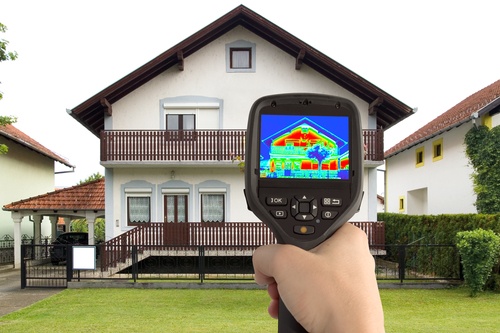
What is the Desirable Value of Resolution for a Thermal Imaging Camera for Home Inspection?
Resolution is a key component of thermal imaging cameras as it affects the performance directly. The ideal value of resolution for these cameras is 320 x 240, which works well for professionals as well as homeowners who want to monitor the condition of their house more closely.
Why Do Thermal Imaging Cameras have Low Resolution?
Thermal imaging cameras have to view a different wavelength of light than regular cameras. To capture this, you need a huge processor if you wanted clearer pixels. So, to keep things handy, the resolution is low in thermal imaging cameras.
Are Thermal Imaging Cameras Any Good for Home Inspection?
Thermal imaging cameras are a great tool for a home inspection. They provide accurate information regarding temperature fluctuations and other issues via heat-sensitive visuals. So, they are a reliable means of keeping a check on your house’s condition.
Can Thermal Imaging Cameras See Through Everything?
No, thermal imaging cameras are not see-through. Rather, they see only the temperature changes as the infrared radiation cannot penetrate through walls. So, you cannot see what is beyond a wall or an obstruction while you are using it.
Final Verdict: What is the Best Thermal Imaging Camera for Home Inspection?
FLIR E8-XT is the best one for you if you want the highest resolution and have no budget constraints.
Meanwhile, you should choose FLIR TG165 Spot Thermal Camera if you want to keep things practical yet affordable.
And, Seek Thermal CompactPRO is your best bet if you like to use your smartphone for inspection work as well.